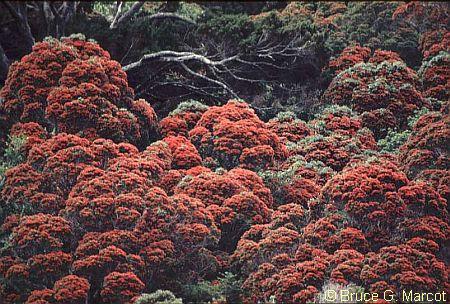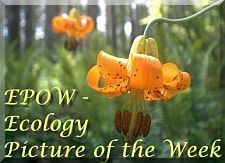Click on the image for a larger version

|
|
Southern Rata: Blooms Ablaze |
|
|
Click on the image for a larger version

|
|
Southern Rata: Blooms Ablaze |
|
Southern Rata (Metrosideros umbellata) in bloom |
Credit & Copyright: Dr. Bruce G.
Marcot
|
Explanation: No, this isn't a forest on fire. It's a full bloom of Southern Rata on Stewart Island in New Zealand. Southern Rata blooms this prolifically only every few years. It seems to be in decline from being consumed by the Brushtail Possum which was introduced from Australia in the 19th century for its soft pelt but which has spread through native forests of New Zealand. The
genus Metrosideros
consists of a diverse set of about 20 species of They are a good example of speciation (evolution of new species), in this case on islands that serve to isolate their gene pools. Perhaps its dispersal by people could be explained by how useful the plants are. Early Maori people of New Zealand used the nectar of rata trees as a food and as a remedy for sore throats, and the inner bark as a remedy for diarrhea. More recently, the nectar is still used to produce "rata honey" ... and the flowers have been shown to contain antiseptics including gallic acid, and the bark to contain ellagic acid which is an effective astringent for diarrhea and dysentery. The Maoris got it right. Also, the outer bark has other medicinal uses and has high tannin content useful for tanning animal hides, and is also used to produce light brown dyes. Southern Rata has wood so dense that locals call it "ironwood." The timber is strong and durable and used for machine bearings, shipbuilding, bridge construction, cartwheels, mallet heads, carving-chisel handles, furniture, and woodturning. Southern Rata is also used as a cultivare. This is one multi-talented plant! In a future EPOW, we will explore some of the birds that have coevolved with Metrosideros as key pollinators on some of these Pacific islands. Information: Crowe, A. 1992. Which native tree? A simple guide to the identification of New Zealand native trees. Viking, Singapore. 64 pp. Poole, A. L., and N. M. Adams. 1994. Trees and shrubs of New Zealand. Manaaki Whenua Press, Lincoln, Canterbury, New Zealand. 256 pp. Wilson, H. D. 1994. Stewart Island plants. Manuka Press, Christchurch, New Zealand. 528 pp. |
Next week's picture: Larval Soldier Fly on the Crawl

Author & Webmaster: Dr.
Bruce G. Marcot, Tom Bruce
Disclaimers and Legal
Statements
Original material on Ecology Picture of the
Week © Bruce G.
Marcot
Member Theme of Taos-Telecommunity